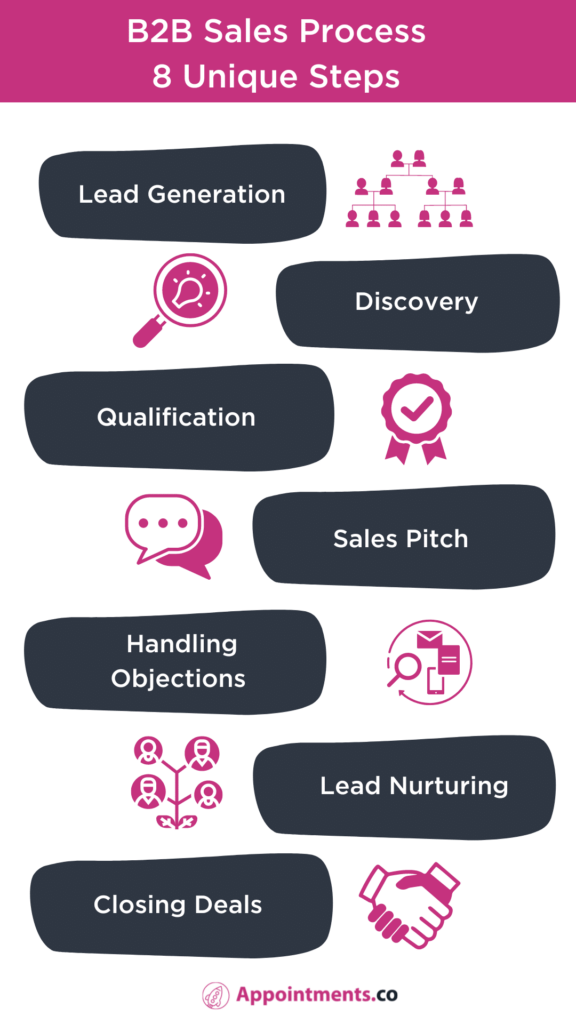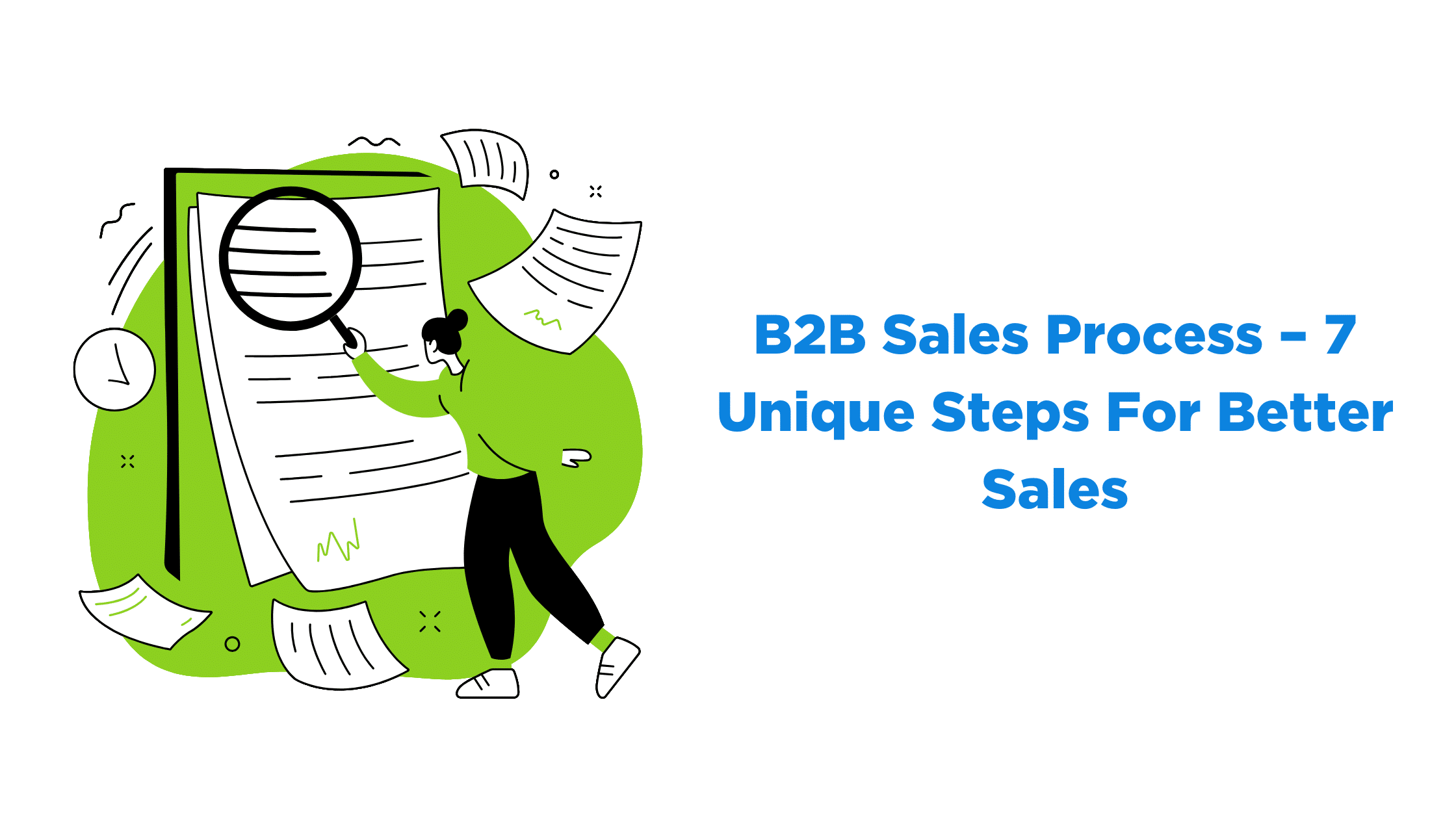The B2B Sales process includes the sequential step-by-step process of a sales cycle. When you sell to businesses, it’s easy to forget that it’s different from selling to people.
Business customers have more to do than buy your product or service. They need a salesperson who knows their company and can close the deal in a way that makes sense for them because they are in charge of several different departments’ budgets, in addition to their own.
B2B salespeople must understand their client’s needs before closing the deal. Instead of relying on your customer experiences, you must determine what your clients want and tailor your product or service to meet those needs.
B2B Sales Process and Definition
Sales are a company’s interactions with customers and prospects. The sales process can make or break a business. With the proper sales process, you can increase profits, market shares, customers, and employees.
B2B sales processes are essential for the growth of a business. Managing it is challenging, but crucial for B2B companies’ success. The stages of a successful B2B sales process are as follows:

Step 1: Lead Generation
Lead generation involves finding potential customers. It involves contacting potential customers and introducing your company.
Advertising, emails, websites, and social media can generate leads manually or digitally. Lead generation’s primary goal is to raise potential customers’ awareness of the company’s products or services so they can be reached later when they start researching online solutions to their company’s problems. Lead generation and emailing newsletters with product updates or special offers can boost sales.
It can be used to build a database of qualified prospects you can contact later, such as during the qualification stage of your sales cycle, when you need more information before moving on to sales negotiations and closing deals. It can also help you build a database of qualified prospects to contact later.
Step 2: Discovery
During the discovery phase of the business-to-business sales cycle, information is gathered about a company, its products and services, and its long-term goals. You can offer solutions to the prospect’s problems if you research and understand the prospect’s issues.
Establishing a deeper connection with your prospects and demonstrating that you understand their needs can bring you closer to closing the deal.
When you research the potential customer, you can qualify the lead before you call. The following tips can help you get started:
- Keep up with industry news. Join LinkedIn groups or industry news websites. When you call potential customers, you want to sound knowledgeable about your industry and theirs.
- Connect with your prospects on LinkedIn. See what they’ve been up to lately. What have they commented on? What’s common? Have they written or been featured in articles? These insights can help you build rapport during cold calls.
- Visit their website. Have they recently released any press releases or news articles? If they have a blog, read it. Take note of the company’s language. Again, all of this information is useful and can be used in your calls.
Step 3: Qualification
The qualification process vets potential customers. It helps you decide if the company will buy your product. With a good qualification process, you can determine what product or service would suit the client’s needs.
Before wasting time and resources on a potential customer, the qualification should be designed to determine whether or not the customer is a good fit for your product or service. Sales reps misqualify prospects before starting the sales process, resulting in 67% of lost sales. For better lead qualification, use a lead scoring system to assess the prospect’s suitability for your business during the initial sales call.
Ask them about their company, industry, and other relevant topics to start the process. Ask about their competitors, customers, and other company details, like how long they’ve been in business.
Having a good lead list means you can speak with plenty of people. If the prospect isn’t a good fit, you can move on to another prospect.
Step 4: Sales Pitch
A compelling pitch is essential to a successful B2B sales process. Selling to potential customers is crucial, but may also be the hardest.
The pitch must clearly show how customers can benefit from your product or service. Your presentation should include all the necessary information. It should also be specific, and not use jargon or unnecessary words.
The pitch should be short, so that the prospect can finish reading or listening to it before they’re distracted by something else. It also should be relevant, meaning it answers the prospect’s questions or needs.
Step 5: Handling Objections
No matter how well your sales rep presents your demo, your prospect may still have doubts. Prospects without a budget, trust in the company, an immediate need, or a sense of urgency are most likely to object during the sales process.
Don’t be surprised if your prospects reject you. Be ready to discuss and address your prospects’ objections when you meet. Listening to a prospect’s objections gives you another chance to pitch your company’s product or service as a solution. Address and resolve potential customers’ concerns about your company.
Step 6: Lead Nurturing
Business-to-business (B2B) sales nurture existing and potential customers to generate leads for future sales. This involves updating customers on new products, services, and deals that may interest them.
Nurturing customers after a sale is a way to keep them coming back for more. If you don’t nurture leads after they buy, you’ll miss a great chance to increase revenue and sales in the future. Nurture emails are sent once or twice a week, and should be personalized.
It works best when nurturing is tailored to the customer’s needs. Don’t just send out generic emails; consider what it would take for this lead to help strengthen your relationship with them. They should also include information about what is happening at your company, such as upcoming events or updates about your product, as well as any other relevant information.
Step 7: Closing Deals
A closing involves securing the order and ensuring that both parties are satisfied with the results of the transaction.
Many different approaches can be taken to successfully close a sale with a prospect. Your sales strategy depends on your prospect’s needs. No matter how you approach it, the sale should end with your company, and you get the prospect’s verbal or written agreement from the customer regarding their intent to purchase your product or service.
Closing is the most crucial step in the sales process, but it is not the end. Nurture your prospect’s company after the sale to maintain your business relationship.
Conclusion
As a business that sells to other companies, you know that sales are crucial. It attracts new customers and turns existing ones into repeat customers.
But, what if you don’t know the process? What if not everyone on your team understands it? What happens when people don’t follow the same procedures, or speak the same language?
There are many ways to streamline B2B sales. You can give your team a framework or a set of guidelines to follow when pitching customers. You can even ensure that everyone has access to the same information by creating a template that everyone uses when contacting potential clients.
Whatever you do, ensure your team knows how significant it is to follow the procedure. This will prevent miscommunication, and team members talking to each other while on the phone with customers.
Plan each step of your B2B sales process to ensure success. This way, you can ensure that every stage of the process is handled correctly and effectively, preventing anything from falling through the cracks and costing you time or money.
Related Reads:
B2B Sales Lead- How To Identify Qualified
7 Tips To Generate High-Quality B2B Sales Leads
The 5 Best B2B Prospecting Tools for Sales
FAQs
1. What causes the B2B sales process to take so long?
Selling from business to business is notoriously time-consuming due to the many people and the numerous stages involved in making the sale.
The buyer must get approval from their boss, who must then get approval from their boss. To make sure your product fits the buyer’s workflow, you must convince them that your product can help them.
Show them how it can increase their productivity at work to persuade them to buy.
2. What is the difference between B2B and B2C?
B2C stands for business-to-consumer, meaning that customers buy products individually. B2B is business-to-business, which refers to a particular kind of exchange between one company and another.
3. What are the most common B2B sales mistakes?
Failing to know who their customers are. It’s essential to understand their business, including challenges and competitors. It can help you to customize each sales pitch in this way. Also, don’t try to sell to everyone at once. To make customers feel comfortable buying from you, build lasting relationships.



